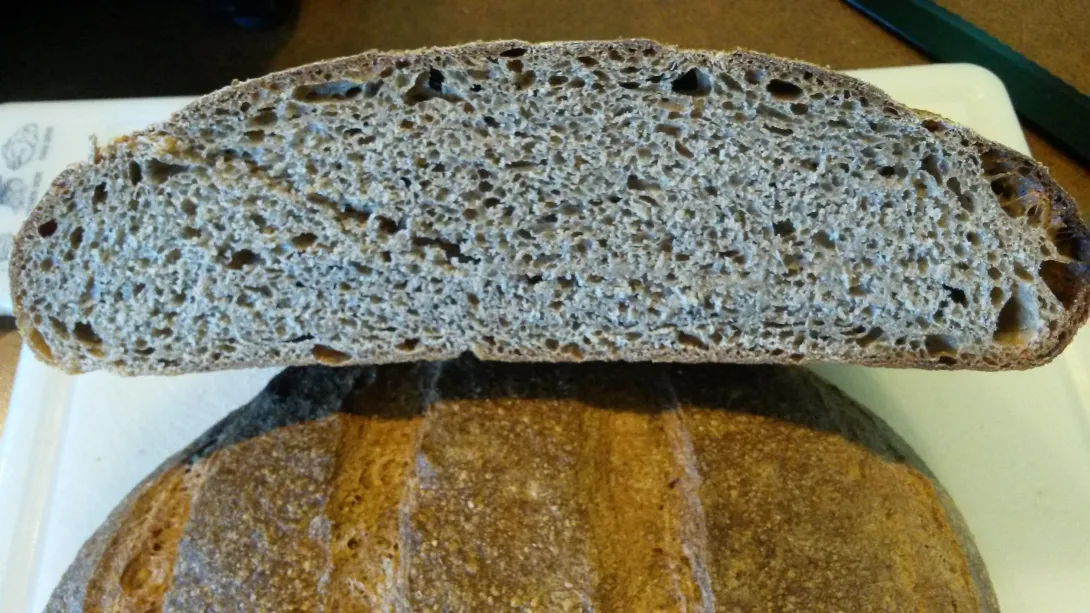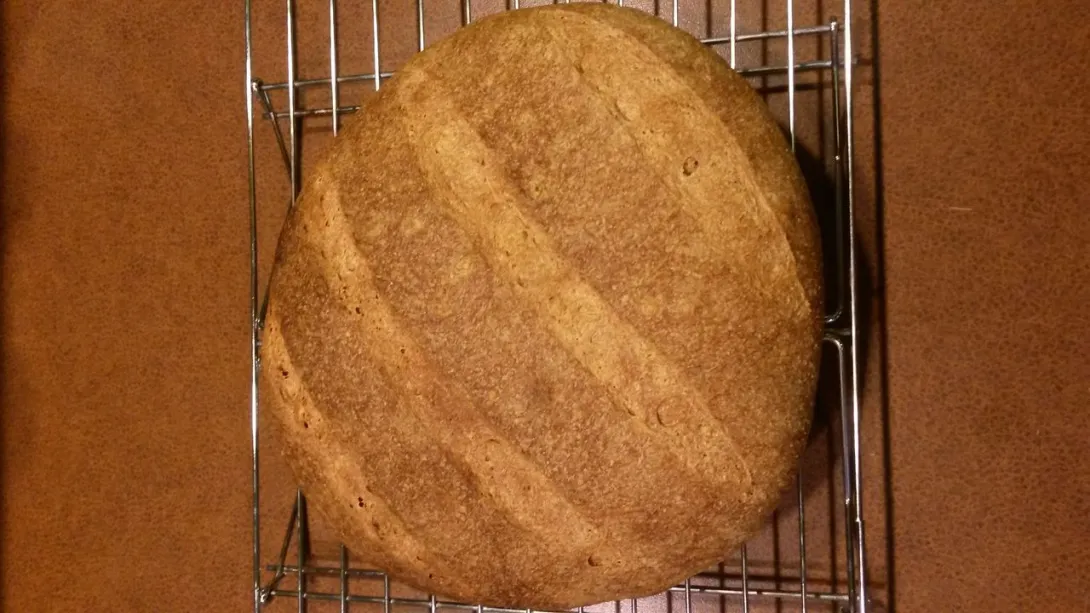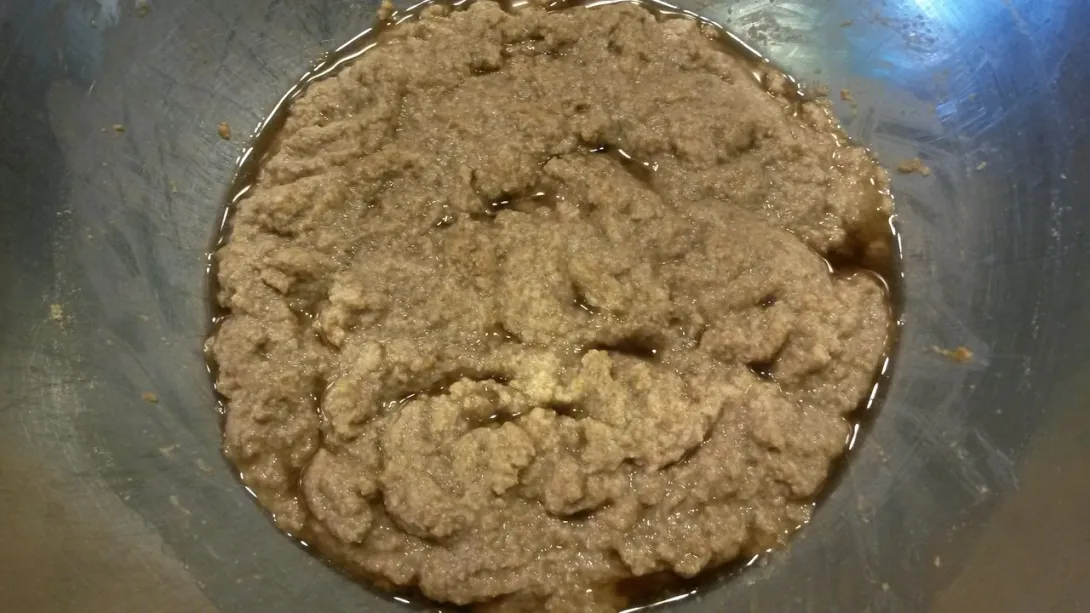
Hi everyone,
I wanted to post this because it was very exciting to me.
As the title states, this was my first try at a 100% whole wheat sourdough. It was 40% hard winter white wheat a friend of mine ground and gave me and the rest was Bob's Red Mill whole wheat flour. I got a cup of WW starter from a neighbor that I fed until I had enough to bake with. She keeps it very wet (somehwere around 150% hydration. She just gives hers a cup of flour and a cup of water every day), but it is very active. I took a piece and am experamenting with giving it less water to see if the activity level goes up of down.
Anyway, I used 265g of starter (fed with BRM flour) and added another 104g of BRM flour and 32g of water to get it down to 100% hydration and let that ferment for four hours.
When that was ready I added it to the 200g of the white wheat, 200g of water and 4g of mineral salt that I had mixed the night before for a 14 hour autolyse. I also mixed in another 5g of salt.
What I got was such a sticky mess I don't know how anyone can make bread at 100% hydration. That was my goal. Most of the 100% WG breads I have seen on here that had a nice oven spring and a nice, open crumb were at or near 100% hydration, so I thought I'd try a loaf at 100% and it didn't work out as I had planned...
I couldn't knead it without it sticking to everything! My hand, the counter, the bowl scraper... It was just too wet. My GF bread is always at 100% hydration, sometimes 105%, so I knew that I'd be dealing with a dough that would be hard to handle, but this was just a mess. I didn't see any way to deal with it but to add more flour. So when all was said and done, I kneaded in another 100g of BRM, feeling like it was still to wet (very tacky, but manageable), figuring that it would be easier to deal with after its first rise. What I ended up with was a very soft dough at 80% hydration.
I didn't write down how long the initial rise was, but it had doubled in size. I think it was around 2 hours, maybe more. Nonethelss, I had to be somewhere for dinner that night, so I opted to just shape and do the final proof. My hat is off to all of you that routinely bake with such wet dough. Shaping was pretty interesting. I ended up doing a boule because I couldn't figure out how to make two batards come out well. I just cupped my hands in a circle around the dough and let it fall through them to stretch the bottom and quickly pinched the bunched up part now in my hands and flipped it over onto parchment. Final proof went well. Doubled in less than an hour sitting on top of my oven in front of the vent where warm air comes out (is that to vent moisture? I've always wondered why that vent is there, but it sure makes my bread proof nicely while the oven preheats.)
Four quick lines to score and into a 500F oven with steam for 15 minutes and then down to 450F for another 15 without steam.

Turns out I didn't score it deep enough, because it swelled up just BEAUTIFULLY! It stretched the scores out to the max right away and then didn't grow anymore. With my GF bread I just need to break the surface of the dough and it willl stretch as much as it wants. But I guess with wheat, you need to give it a little more room to grow. So I decided to buy a lame.
Anyway, sorry to write a novel, but I was hoping to get some feedback on my technique and the recipe so I gave as much detail as I could.
One more question. When I mixed the white wheat flour that my friend milled, it seemed a little corse and the mixture come out less like a dough and more like a grainy batter. After the 14 hour autolyse with the mineral salt, it had this brown liquid that had separated from it.

Have any of you ever seen anything like this? What is it? I tried doing a few searches on here but couldn't find anything like this.
Thanks for looking,
Daniel
PS: I forgot the most important part; Everyone that I gave the bread to loved it and couldn't believe it was 100% whole wheat! They said it didn't have a really strong sourdough flavor, but that it had just enough. One even said it was a little sweet which I was glad to hear because I didn't even add honey.
Can't get a better compliment then that.
Your recipe:
200g white wheat flour + another 100g
200g water
9g salt
400g Starter @ 100% hydration (was 401g but we'll call it 400g)
Well before you added that extra 100g no wonder you couldn't handle it. It was 100% hydration dough.
You also autolysed with salt. Autolyse is just flour + water (and sometimes with the starter but obviously for shorter time, usually 30 minutes but never with salt).
You made a lot!! of starter then thickened it up with more flour.
I usually do wholewheat at around 75% hydration but you handle 80% hydration very well so let's keep it at that. Just to re-arrange the recipe a bit...
RECIPE:
450g wholewheat
351g warm water
9g salt
90g starter
Night before build your starter: 18g Starter + 36g water + 36g flour
Next morning when your starter is active and bubbly then proceed....
1. Autolyse the 351g warm water + 450g whole-wheat for 30 minutes
2. After 30 minutes... sprinkle the 9g salt over the dough followed by the Starter. Squeeze and fold the dough till it's fully incorporated. Cover and rest for 10 minutes.
3. [Now normally you'd incorporate stretch and folds through the bulk fermentation but for now]... knead the dough till full gluten formation then cover and bulk ferment till doubled.
4. Tip the dough out onto a lightly floured surface and shape the dough into prepared banneton.
5. Final proof till ready - till just under doubled.
6. Bake in pre-heated oven.
`00% WW. Using US flours like Red Mill lets you up the hydration to 95 - 105 % to really open the crumb. You want to do a 2 hour autolyse - no salt and no levain and keep the prefermented flour down to 15% in the winter and 10% in the summer. WW moves fast for ferment and proof and you want to get it the oven at no more than 85% proof to keep it from spreading and going a bit flat. Well done and
Happy WW baking
Abe,
I appreciate the insight. I will make some adjustmenst to the recipe acordingly. Gonna bake another batch tomorrow so I'll get that starter going tonight. So I add the flour and water and leave it out at room temp, or in the fridge? I appologize if that's a noobie question, but this was only my fourth time baking with wheat.
I realized after reading your comments that I did have quite a lot of starter in that recipe (truth be told, I just sort of made it up. I have been using the master formula from Peter Reinhart's WGB book as a basis and just going from there). I will give it a shot with the amount you recomended.
dabrownman,
Thanks for the tips. Truth be told, your 100% WW double levian at 100% hydration was one of the reasons I decided to give WW baking a shot. Some of my friends were convinced that WW bread would never be able to have the light and open crumb of their AP flour counterparts, so I took up the challenge and began doing research. Your post was one of the first things I found and it gave me a great deal of hope. Now, having seen all the other fabulous 100% WG breads the members have come up with here (this comes to mind in particular http://www.thefreshloaf.com/node/22483/36-hours-sourdough-baguette-100-whole-grain-finale-not-end), I am looking forward to learning from you all.
saw the crumb on her 100% while grain baguettes. Lucy fashions Ying (txfarmer) the lost grand daughter of Emperor Ming of Mordor (of Flash Gordon fame) because her baking is out of this world! Something for us mere mortals to shoot for in our pipe dreams:-) Treating the boule dough like she does in her 36 hour saga should make for the most open crumb, soft and crumb possible for you at this time. A fun bake for sure.
Just do the autolyse on the counter - its wintertime. I know some Fresh Lofians of note, janetcook comes to mind, autolyse their WW for 8 hours or overnight. I don't shoot for awide open crumb on WW breads but I do like fairly open, soft and moist.
Keep after it .....and happy baking
My method of starter maintenance and using within a dough...
I build about 100-150g of mother starter, allow it to bubble up by half and then keep it in the fridge. This way it has plenty of food to keep it going between feeds.
When it comes to baking i'll take some off and build more starter like in the recipe example (at room temperature). Allow that to bubble up and mature overnight and then use the next morning.
When my starter in the fridge runs low (never less than 1 tablespoon), or starts producing hooch, i'll take it out, feed it, allow it to bubble up by half and then return it to the fridge.
This allows me to not keep too much starter at any one time, allows me to do starter builds with different flours and/or hydration all the while keeping my mother starter 100% whole rye (which keeps very well by the way as rye lends itself well to starters and needs less TLC) and i'm not slave to my starter having to keep feeding it and/or discarding. With this method there is no wastage.
There are many ways to maintain and use a sourdough starter. I doubt anyone on this site or anyone anywhere has exactly the same method. So by all means take advice from this forum, get ideas and just by using your starter you'll come up with a method that suits your own needs.
Looking forward to your next loaf.
You asked the question "what is the brown liquid that separated out from the dough?" It looks an awful lot like the hooch you get on top of a dormant starter when it's been in the fridge for a while, especially starter made with WW flour. This is mildly alcoholic and is a by-product of the fermentation. Don't drink it though, it can be really hard on the body! Some people pour it off their starter because of its strong flavour; others mix it in. It's a matter of taste, I expect!
LL
Thanks for the reply LL.
The thing is though, that that brown liquid was in the "soaker," the dough that I had mixed to autolyse overnight. There should have been no fermentation happening in there because there was no leavening. All I had mixed into that bowl was equal parts water and white whole wheat flour that a friend of mine milled for me and I have kept in the fridge since Christmas plus a little bit of salt per the method PR outlines for his "soaker" in his WGB book.
The only thing I can think of that may have caused that was that the flour seemed a little corse to me. Maybe I had saturated it? If the flour had absorbed all the water it could and there was still some extra, it may have made some sort of extract, a tea of sorts. I didn't taste it since gluten and I don't get along, so I have no idea what it was yet.